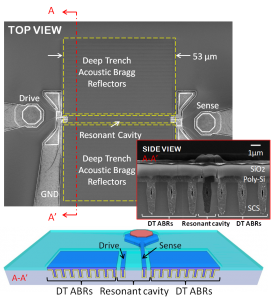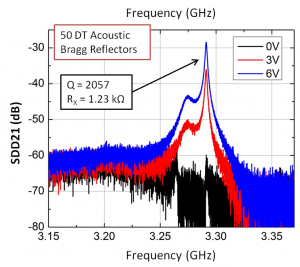Deep Trench Capacitor Drive of Unreleased Si MEMS Resonator
- Category: MEMS & BioMEMS
- Tags: dana weinstein, wentao wang
With frequency-quality factor products (f•Q) often exceeding 1013, MEMS resonators offer a high-Q, small footprint alternative to conventional LC tanks and off-chip crystals for clocking and wireless communication. Over the past three decades, much progress has been made in the key figures of merit of MEMS resonators including small footprint, high Q, low motional impedance, and efficient energy coupling kT2. In parallel, efforts have focused on system-level metrics including high yield, low cost, robustness, easy packaging, and integration with circuits. A key challenge in MEMS resonator design is to achieve high performance yet manufacturable devices. The unreleased deep trench (DT) resonators in this work address this challenge.
Beyond the performance goals of high Q and low loss, these devices target two key features desired for monolithically integrated MEMS resonators. First, lithographic definition of resonance frequency enables a broad range of frequencies to be fabricated on a single chip. Second, unreleased bulk-acoustic resonators do not require any low-yield, complex steps to freely suspend the moving structure and are robust in harsh environments without packaging. Unreleased resonators such as the HBAR[1] have been demonstrated but have thickness-defined frequency. Lateral bulk acoustic resonators with lithographically defined frequency such as the LoBAR[2] have achieved high Q but require low d31 coupling to drive and sense resonance. Meanwhile, sidewall AlN resonators[3] excite lateral resonance with d33 coupling but still require a release step. This work provides the benefits of all of these devices with high Q, efficient dielectric transduction, lateral resonance, and no release step. The DT resonator implements deep trench capacitors as both electrostatic transducers and Acoustic Bragg Reflectors (ABRs), defined in a single mask and self-aligned (Figure 1). While ABRs provide acoustic isolation in a solid medium, the DT capacitors function as internal dielectric transducers[4], which have achieved the highest frequencies in Si to date[5]. A 3.3-GHz unreleased Si resonator is demonstrated with Q of 2057 and motional impedance RX of 1.2 kΩ (Figure 2). This realization of high-Q unreleased resonators in a bulk Si process provides a high yield, low cost, no packaging solution for on-chip clocking, wireless communication, and electromechanical signal processing.
- Figure 1: Scanning electron micrographs (top) and schematic (bottom) of unreleased deep trench (DT) MEMS resonator. Acoustic Bragg reflectors (ABRs) formed from periodically spaced DTs define a high-Q resonant cavity in the center of the device. DT capacitors inside the resonant cavity form electrostatic drive and sense transducers.
- Figure 2: Measured frequency response of DT resonators with 7.2-µm-long resonant cavity, DT length of 950 nm, and 1.7-µm DT pitch in the ABRs. Device with 50 ABRs is shown. Wide frequency sweeps show no spurious modes in a multi-GHz range.
- J. T. Haynes, M. S. Buchalter, R. A. Moore, H. L. Salvo, S. G. Shepherd, and B. R. McAvoy, “Stable microwave source using high overtone bulk resonators,” IEEE MTT-S 1985, pp. 243-246. [↩]
- M. Ziaei-Moayyed, S. D. Habermehl, D. W. Branch, P. J. Clews, and R. H. Olsson III, “Silicon carbide lateral overtone Bulk Acoustic Resonator with ultrahigh quality factor,” IEEE MEMS, 2011, pp. 788-792. [↩]
- R. Tabrizian, and F. Ayazi, “Laterally excited silicon Bulk Acoustic Resonator with sidewall AlN,” Transducers 2011, pp. 1520-1523. [↩]
- D. Weinstein, and S. A. Bhave, “Internal dielectric transduction of a 4.5 GHz silicon bar resonator,” IEDM 2007, pp. 415-418. [↩]
- W. Wang, L.C. Popa, R. Marathe, and D. Weinstein, “An unreleased mm-wave resonant body transistor,” IEEE MEMS, 2011, pp. 1341-1344. [↩]

